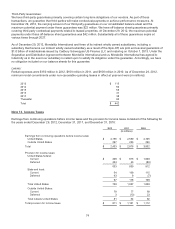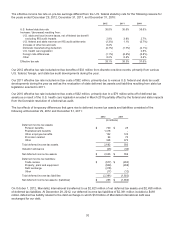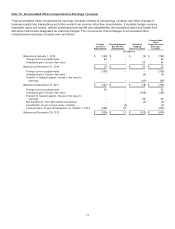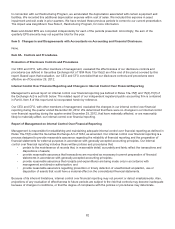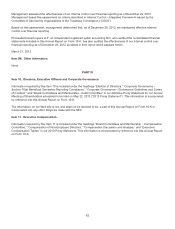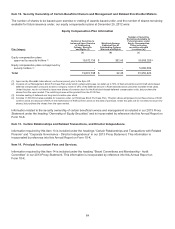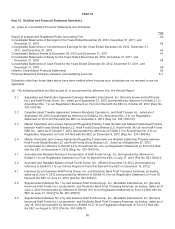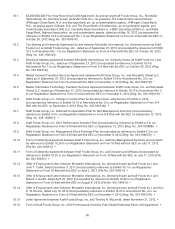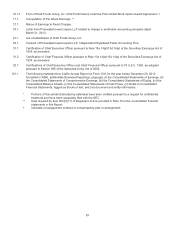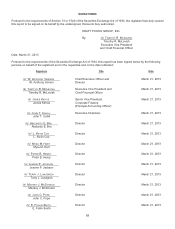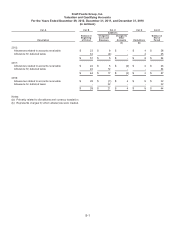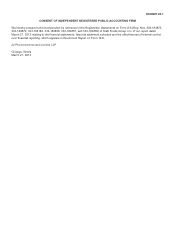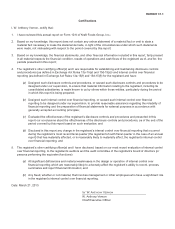Kraft 2012 Annual Report Download - page 84
Download and view the complete annual report
Please find page 84 of the 2012 Kraft annual report below. You can navigate through the pages in the report by either clicking on the pages listed below, or by using the keyword search tool below to find specific information within the annual report.In connection with our Restructuring Program, we accelerated the depreciation associated with certain equipment and
facilities. We recorded this additional depreciation expense within cost of sales. We included this expense in asset
impairment and exit costs in prior quarters. We have revised these previous periods to correct to our current presentation.
The impact was insignificant. See Note 6, Restructuring Program, for more information.
Basic and diluted EPS are computed independently for each of the periods presented. Accordingly, the sum of the
quarterly EPS amounts may not equal the total for the year.
Item 9. Changes in and Disagreements with Accountants on Accounting and Financial Disclosure.
None.
Item 9A. Controls and Procedures.
Evaluation of Disclosure Controls and Procedures
Our CEO and CFO, with other members of management, evaluated the effectiveness of our disclosure controls and
procedures (as defined in Securities Exchange Act of 1934 Rule 13a-15(e)) as of the end of the period covered by this
report. Based upon that evaluation, our CEO and CFO concluded that our disclosure controls and procedures were
effective as of December 29, 2012.
Internal Control Over Financial Reporting and Changes in Internal Control Over Financial Reporting
Management’s annual report on internal control over financial reporting (as defined in Rules 13a-15(f) and 15(d)-15(f) of
the Exchange Act) is set forth below. The related report of our independent registered public accounting firm is contained
in Part II, Item 8 of this report and is incorporated herein by reference.
Our CEO and CFO, with other members of management, evaluated the changes in our internal control over financial
reporting during the quarter ended December 29, 2012. We determined that there were no changes in our internal control
over financial reporting during the quarter ended December 29, 2012, that have materially affected, or are reasonably
likely to materially affect, our internal control over financial reporting.
Report of Management on Internal Control Over Financial Reporting
Management is responsible for establishing and maintaining adequate internal control over financial reporting as defined in
Rules 13a-15(f) under the Securities Exchange Act of 1934, as amended. Our internal control over financial reporting is a
process designed to provide reasonable assurance regarding the reliability of financial reporting and the preparation of
financial statements for external purposes in accordance with generally accepted accounting principles. Our internal
control over financial reporting includes those written policies and procedures that:
• pertain to the maintenance of records that, in reasonable detail, accurately and fairly reflect the transactions and
dispositions of assets;
• provide reasonable assurance that transactions are recorded as necessary to permit preparation of financial
statements in accordance with generally accepted accounting principles;
• provide reasonable assurance that receipts and expenditures are being made only in accordance with
management and director authorization; and
• provide reasonable assurance regarding prevention or timely detection of unauthorized acquisition, use or
disposition of assets that could have a material effect on the consolidated financial statements.
Because of its inherent limitations, internal control over financial reporting may not prevent or detect misstatements. Also,
projections of any evaluation of effectiveness to future periods are subject to the risk that controls may become inadequate
because of changes in conditions, or that the degree of compliance with the policies or procedures may deteriorate.
82




